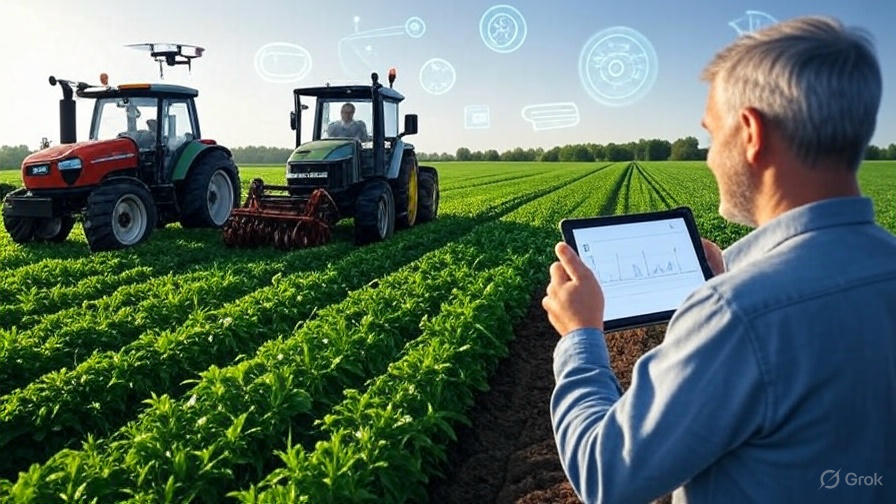The Smart Farming Revolution
Agriculture has always evolved with the times—from hand tools to tractors, from irrigation canals to drones. But today, we’re entering a new phase of evolution: AI-powered agriculture. Artificial Intelligence (AI) is not just helping farmers grow more food—it’s transforming how, where, and when they grow it.
By combining machine learning, computer vision, IoT sensors, and robotics, AI is delivering real-time insights, automation, and predictive power into the hands of farmers. The result? Higher yields, lower costs, and sustainable practices that meet the food demands of a growing world.
1. Precision Farming: Tailoring Every Inch of Soil
Precision agriculture is perhaps the most visible application of AI in farming. Using AI-driven data analytics, farmers can:
-
Map soil variability to understand nutrient distribution
-
Predict ideal sowing times based on historical weather data
-
Apply fertilizers and pesticides only where needed
-
Optimize irrigation patterns for water conservation
AI enables hyper-local decision-making, increasing crop productivity while minimizing environmental impact.
2. Crop Health Monitoring with Computer Vision
AI-powered computer vision systems—often mounted on drones or smartphones—can detect:
-
Diseases like leaf spot, mildew, or rust
-
Pest infestations before they spread
-
Nutrient deficiencies based on leaf color
-
Plant growth stages and yield estimation
These insights allow farmers to respond earlier, reducing losses and minimizing chemical use. Platforms like Plantix, Taranis, and IBM’s Watson Decision Platform for Agriculture are already in use globally.
3. Predictive Analytics and Yield Forecasting
AI thrives on data—and agriculture is now generating terabytes of it. By analyzing historical weather, crop performance, soil health, and satellite imagery, AI models can:
-
Predict crop yields with high accuracy
-
Identify climate and disease risks
-
Forecast market demand and pricing
-
Optimize harvest schedules
This intelligence helps farmers and supply chains plan better, reduce waste, and maximize profits.
4. Autonomous Equipment and Robotics
AI is enabling the rise of autonomous tractors, robotic harvesters, and precision weeders. These machines use sensors, GPS, and machine learning to:
-
Navigate fields with minimal supervision
-
Plant seeds at optimal depths and spacing
-
Spray only infected areas, reducing chemical use
-
Harvest delicate crops with robotic precision
Companies like John Deere, Blue River Technology, and Naïo Technologies are leading this smart equipment revolution.
5. Smart Irrigation and Water Management
AI systems connected to IoT sensors monitor:
-
Soil moisture
-
Weather patterns
-
Crop water needs
Based on this data, AI can control irrigation systems to:
-
Deliver water only where needed
-
Predict drought risks
-
Reduce water waste by up to 30% or more
This is especially critical in arid regions where efficient water use means survival.
6. Supply Chain Optimization and Market Intelligence
Beyond the farm, AI helps streamline the entire agricultural supply chain:
-
Real-time logistics tracking for freshness and safety
-
Demand forecasting to reduce food waste
-
Price prediction models to help farmers sell at the right time
This reduces post-harvest losses and helps build smarter, more connected farm-to-fork ecosystems.
7. Climate-Smart Agriculture
AI helps farmers adapt to climate change with:
-
Simulated weather models for resilient crop planning
-
Disaster prediction (e.g., floods, droughts, locusts)
-
Adaptive planting schedules
-
Early warning systems integrated with satellite and ground data
By empowering farmers with foresight, AI makes agriculture not just smarter—but more resilient.
8. Livestock Health Monitoring
In animal farming, AI monitors livestock using wearable sensors, cameras, and thermal imaging to:
-
Detect diseases early
-
Monitor feeding behavior and activity
-
Track breeding cycles
-
Predict veterinary needs
This improves animal welfare, increases productivity, and reduces treatment costs.
Challenges and Considerations
AI’s potential in agriculture is immense, but barriers remain:
-
High initial costs for AI tech and infrastructure
-
Data privacy and ownership concerns
-
Digital divide for smallholder and rural farmers
-
Need for local adaptation of global AI models
Addressing these gaps through policy, training, and inclusive design is key to democratizing Agri-AI.
Conclusion: From Fields to the Future
AI is not replacing farmers—it’s amplifying their wisdom. With the ability to analyze complex data, automate labor, and predict outcomes, AI is reshaping agriculture into a more productive, profitable, and sustainable industry.
As we look to feed a growing population while preserving the planet, AI will be one of agriculture’s most valuable harvests.
Visit our Website: VinesNest





